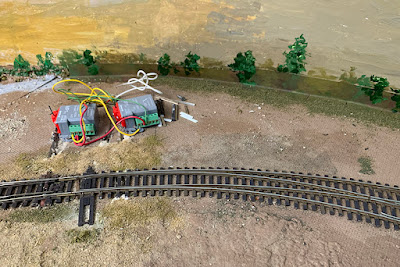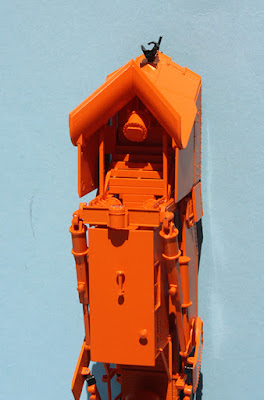Here I am referring to the faces and treads of wheels on model railroad cars. These are not terribly prominent features on either prototype or model cars, but they should still look “right” on a layout or even in a display case. For background on how trucks are constructed and a little about modeling them, you may wish to look at my article in Model Railroad Hobbyist, September 2016. (This issue is still available for free, to read on-line or download, at www.mrhmag.com .)
I will begin with an informative overview of what a truck looks like. It happens to be a Bettendorf T-section truck, the later version with the little rib above the journal box connecting onto the frame, very visible in this view. The wheelsets (wheel-axle assemblies) are faded out in this view so the bolster and side frames can be seen better. (Bettendorf graphic, Car Builders Cyclopedia, 1919)
The parts of the wheelsets that we can see in models are primarily the outer wheel faces and the treads. The inner faces and axles are not very visible on most model cars. Since I model during the transition era, when roller bearings were still fairly uncommon, the solid-bearing truck technology was predominant. The journal boxes you see above would be opened to add lubricating oil to the journal box, and inevitably this leaked out of the back of the box onto the wheels.
The result was an accumulation of oil on wheel faces, which of course attracted and held dust and dirt from the right-of-way. Before long a rather thick layer of oily “crud” characterized every wheel face. The photo below (taken at the Portola museum by Richard Hendrickson) illustrates what I mean. Note, incidentally, that the cast steel bolster is hollow and you can see clear through it. You may click on the image to see the wheels more clearly.
Of course, new model trucks, and the trucks on “ready-to-run” models are nothing like this, but are in most cases quite shiny. I show a single example below, though not the most extreme; some machined wheels from China are even shinier.
Obviously we should correct this appearance, another example of what my late friend Richard Hendrickson meant when he said such models should be called “ready to finish” rather than “ready-to-run.” (For background on Richard, see: https://modelingthesp.blogspot.com/2014/07/in-memoriam-richard-hendrickson.html .)
I generally brush-paint wheel faces a dark gray color, often Tamiya “German Gray,” XF-63. It’s important to make sure the wheel rims are painted too. Many Chinese wheels have rather wide rims, unlike the ones you see in the photo above.
Next comes the issue of wheel treads. In service, these become shiny upon first use, and remain that way if the car is at all regularly moved. Richard Hendrickson invariably polished the treads of his model wheels, using his Unimat lathe, even when the wheels were the old “fat” width, 0.110 inches. Here’s an example. Note that he also has painted the axles and inner wheel faces, something I usually don’t do.
I must confess I part ways with Richard on this one. Polishing the treads of fat wheels merely emphasizes how fat they are. It’s actually a little embarrassing to remind ourselves how narrow the prototype wheel tread really is. Below is an undated Standard Oil photo, taken at Bayway, New Jersey of tank car unloading through bottom outlets (CYCX was the reporting mark of the Conley Tank Car Company). The wheel width in this photo attracts my eye like a magnet.
Even our “semi-scale” HO wheels, 0.088 inches wide, are at least 50 percent larger than what you see in the photo above. I guess I prefer not to remind myself or any viewer that we are still well oversize in our wheel treads. I don’t paint them, but I don’t polish them either.
These comments are just for your consideration, and certainly aren’t meant as firm directions for any modeler other than myself. But these are topics that I think deserve consideration before deciding how you wish to finish your models.
Tony Thompson













































